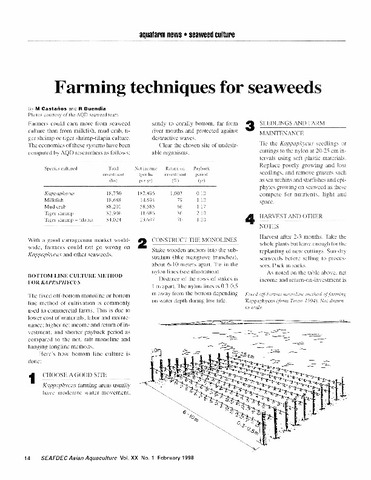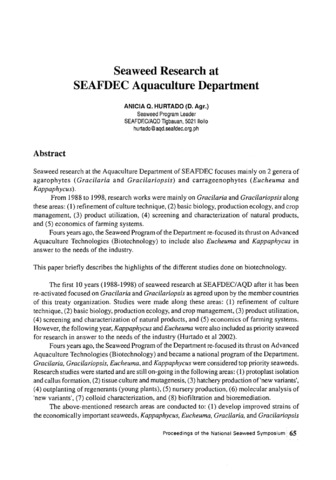Perlihatkan publikasi sederhana
Resiliency of Gracilariopsis heteroclada (Zhang et. Xia) carpospores at different salinity and temperature levels
| dc.contributor.author | Mateo, Jonalyn | |
| dc.coverage.spatial | Philippines | en |
| dc.date.accessioned | 2024-07-25T04:03:57Z | |
| dc.date.available | 2024-07-25T04:03:57Z | |
| dc.date.issued | 2019-07 | |
| dc.identifier.citation | Mateo, J. P. (2019). Resiliency of Gracilariopsis heteroclada (Zhang et. Xia) carpospores at different salinity and temperature levels [Unpublished master’s thesis]. University of the Philippines Visayas. | en |
| dc.identifier.uri | http://hdl.handle.net/10862/6547 | |
| dc.description.abstract | Environmental factors like temperature and salinity play an important role in the growth and reproduction of aquatic organisms. The change in these two factors will be a major challenge in the future. Development of different culture techniques for Gracilariopsis heteroclada (Zhang et. Xia), a species usually found in the Philippines are being undertaken due to its increasing demand, however, there is a rapid depletion of natural populations. This study tested the resiliency of Gp. heteroclada to different water temperatures and salinities. Diploid spores from mature cystocarpic thalli of Gp. heteroclada were shed and grown at different temperatures and salinities under laboratory condition. Higher germination rate was obtained at 20°C (152.21 ± 69.88 carpospores) and 30°C (155.58 ± 66 carpospores) than at 40°C (7.56±6.54 carpospores) and 10°C (no spores were shed). Carpospores shed at 40°C degraded after 3 days. Growth rates of carpospores cultured on slides at 20 °C ranged from 2.37 to 5.92% day-1 while carpospores at 30°C ranged from 2.02 to 3.44% day-1. When carpospores were transferred to aerated vessels, growth rates decreased. At 20 °C, growth rates ranged from 0.84 to 2.96 % day-1 while at 30°C, growth rates ranged from 1.65 to 2.56 % day-1. Development rates had a wide range from 0.51 to 27.27% at 20 °C while at 30 °C, development rates ranged from 1.27 to 30 %. These results showed that Gp. heteroclada can shed carpospores at a range of 20-40 °C and 20-40 ppt. However, carpospores cannot fully develop at 40 °C. Optimum temperature for growth was at 20 °C and can grow at a wide range of salinity (20-40 ppt). | en |
| dc.language.iso | en | en |
| dc.title | Resiliency of Gracilariopsis heteroclada (Zhang et. Xia) carpospores at different salinity and temperature levels | en |
| dc.type | Thesis | en |
| dc.subject.asfa | climate change | en |
| dc.subject.asfa | seaweeds | en |
| dc.subject.asfa | salinity | en |
| dc.subject.asfa | temperature | en |
| dc.subject.asfa | seaweed culture | en |
| dc.subject.asfa | spores | en |
| dc.subject.scientificName | Gracilariopsis heteroclada | en |
| local.subject | agarophyte | en |
| local.subject | Gracilariopsis heteroclada | en |
| local.subject | climate change | en |
| local.subject | sporulation | en |
| local.subject | resiliency | en |
| local.subject | carpospores | en |
| thesis.degree.discipline | Fisheries Biology | en |
| thesis.degree.grantor | University of the Philippines Visayas | en |
| thesis.degree.level | Masters | en |
| thesis.degree.name | Master of Science in Fisheries Major in Fisheries Biology | en |
| dc.subject.sdg | SDG 13 - Climate action | en |
| dc.subject.sdg | SDG 14 - Life below water | en |
Files in this item
| Files | Size | Format | View |
|---|---|---|---|
|
There are no files associated with this item. |
|||
Publikasi ini ada di koleksi berikut
-
Masters Theses [2]




